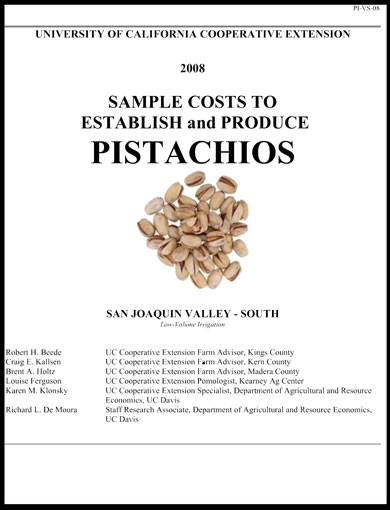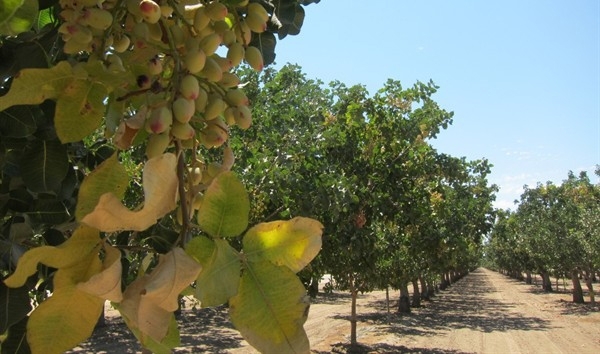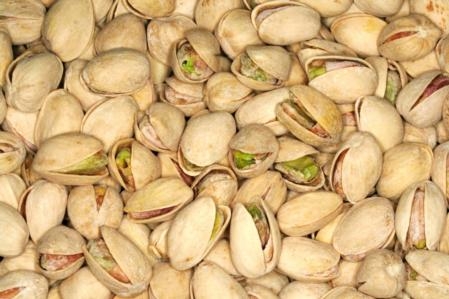Posts Tagged: pistachios
Climate and California agriculture of the future
One of the forces driving agricultural experiments in California's fertile San Joaquin Valley is climate change, reported Mark Schapiro on Grist.org. Although some sources still don't feel completely comfortable with the concept.
"Whether it's carbon built up in the atmosphere or just friggin' bad luck, the conditions are straining us," said John Duarte, president of Duarte Nursery.
The state's fruit and nut orchards are taking the most heat as conditions change. A fruit or nut tree planted today may be ill-suited to climatic conditions by the time it begins bearing fruit in 5 or 10 years. Between 1950 and 2009, “chill” hours trees needed annually to reboot trees' metabolic system for the spring bloom had already declined by as much as 30 percent, according to a California Department of Food and Agriculture study.
“If trees haven't had that low-chill period when they wake up in the spring, it's like being up all night and then trying to go to work.” said Mae Culumber, a nut crop advisor with UC Cooperative Extension in Fresno County.
Researchers have already observed that cherry, apricot, pear, apple, pecan and almond trees are often less productive than they used to be.
The article said farmers may turn to pistachio trees to weather a warmer and dryer California. Pistachio trees require one-third to one-half as much water as almond trees. During droughts, pistachio tree metabolism slows and when water returns, they start producing nuts again. And they can produce nuts for 80 years or longer, almost four times the life span of an average almond tree.
For field crops, scientists are looking at improving the soil and transforming growing systems to help farmers adapt to the warming climate.
“When I drive to the Central Valley, I get goosebumps; I feel the urgency,” UC Davis agronomist Amélie Gaudin said. “I see an agriculture that is basically hydroponics. It's like a person being fed/kept alive by an IV.”
“What happens when you no longer have the sugar-water?” she adds.
Gaudin is focusing on using agroecological principles to develop efficient and resilient cropping systems. Planting cover crops and reducing tillage show promise for mitigating the impact of climate change in the valley.
Too many California pistachios coming up empty
Some California pistachio farmers are facing one of their worst harvests ever, reported Sarah Zhang on Wired.com.
UC Agriculture and Natural Resources experts said the dip in yield cannot be blamed on the drought, but a warming climate may be coming into play. Pistachios require cold winter temperatures to reset their biological clocks.
“They use the temperature to know when winter is over,” said Craig Kallsen, UC Cooperative Extension advisor in Kern County. “And if they don't get the message, they get confused.”
Male trees then end up blooming after the female tree. If female plants don't get fertilized when they bloom, they still produce shells—just empty ones.
Kallsen said the hardest hit regions are in the Southern San Joaquin Valley.
"We're looking at a record low (yield)," Kallsen said.
Farmers to the north had more chilling hours, so they are seeing a normal or low number of empty pistachio shells.
Growers have found that spraying oil can help trees bloom more uniformly, however, it doesn't always seem to help, the story said.
“There are a lot of things we're still trying to understand,” said Gurreet Brar, UC Cooperative Extension advisor in Fresno County. “Oil applied at the wrong time or in inappropriate conditions like water stress conditions can injure the plant.”
Pistachio crop threatened by fungus
The California Report, a popular radio news program that is broadcast throughout the state on public radio stations, devoted five minutes this morning to a solution found at the UC Kearney Agricultural Research and Extension Center for a serious pistachio production problem.
Reporter Alice Daniel interviewed Kearney-based UC Davis plant pathologist Themis Michailides, who led the team that discovered how to expose pistachio trees to spores of a beneficial fungus that displaces the fungi that produce aflatoxin.
Though the story was broadcast this morning, it can still be heard on The California Report website and is embedded below:
For more information on the beneficial fungus, AF-36, which was used for the first time in commercial pistachio orchards this past summer, read Pistachio farmers enlist a beneficial fungus to battle aflatoxin.
California nut harvest winding down
- Almond growers expect to meet an early estimate of 1.95 billion pounds statewide, which would be a record
- Pistachio growers in the San Joaquin Valley are enjoying their second-largest crop ever after last year's record yield
- Walnut growers expect this year's yield to be 485,000 tons, slightly lower than last year's 503,000 tons
"The rumors I've heard is that guys are still complaining about the quality" of walnuts, said Rick Buchner, a University of California Cooperative Extension farm advisor in Red Bluff. "We're getting a lot of black husks on them, so there's a suggestion that we may have some husk breakdown and husk fly problems. It's probably too soon to tell yet."
Pistachio Association uses UC data to calculate the crop's economic impact
The economic impact of the pistachio industry in California, Arizona and New Mexico amounts to $1.9 million for each day of the year, $682.5 million annually, according to a report commissioned by the Western Pistachio Association. The greatest economic impact is in California, where the majority of pistachios are grown.
Consultant Dennis H. Tootelian arrived at these figures using data from the Census of Agriculture, USDA, CDFA, and the University of California Cooperative Extension's Sample Costs to Establish and Produce Pistachios, according to a news release WPA distributed today via PR Newswire.
"The goal of the study was to demonstrate the overall impact of the pistachio growers' spending and their ability to generate business activity, employment, personal income and tax revenue for other industries and the states they operate in overall," Tootelian was quoted in the release.
The $682.5 million economic impact takes into account the "ripple effect" of pistachio business activity. For example:
- Pistachio growers spend nearly $415.3 million each year to produce the pistachio crop
- This spending spurs creation of 5,910 full-time equivalent jobs each year
- The employment generates more than $224.4 million each year in wages and salaries for new employees, and expanded incomes for existing industry jobs
- More than $24.4 million annually in tax revenue and other business licenses and fees are generated
"This report shows us how we as an industry contribute to the economy – through substantial job creation, funding for community programs, literally millions in tax revenues to the states where growers operate – all by simply growing the best possible product for consumers," said WPA executive director Richard Matoian.
The complete economic impact report may be viewed on the Western Pistachio Association's website.

UCCE's pistachio cost study.





